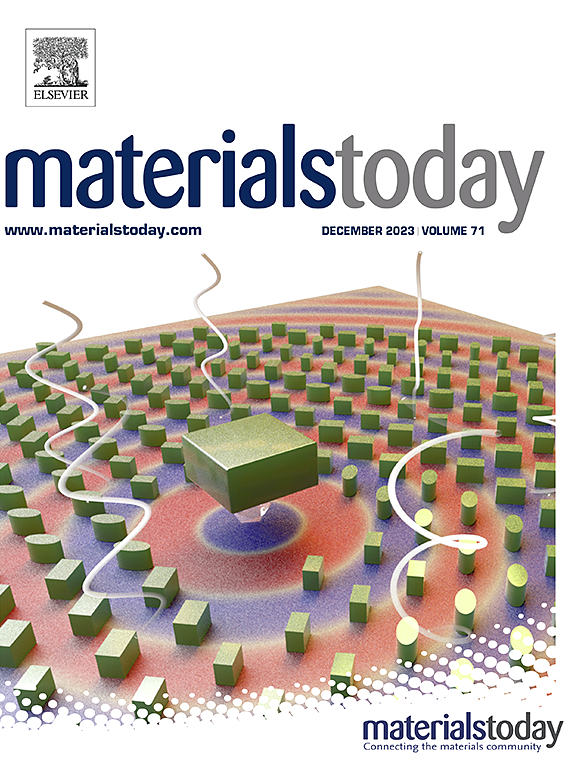III-V quantum dots: A multidimensional exploration from eco-friendly materials to near infrared optoelectronic applications
IF 21.1
1区 材料科学
Q1 MATERIALS SCIENCE, MULTIDISCIPLINARY
引用次数: 0
Abstract
III-V (InP, InAs, InSb) quantum dots (QDs) have emerged as promising alternatives to lead/cadmium-based QDs due to their lower toxicity and tunable optoelectronic properties. Advances in colloidal synthesis have enabled the development of heterostructures, ligand engineering, and surface modifications in III-V QDs, allowing for spectral tunability from blue to near-infrared (NIR), narrow emission linewidths, and high quantum yields. Furthermore, III-V QDs exhibit higher covalency compared to lead/cadmium-based counterparts, enhancing their performance in various applications: the state-of-the-art InP QDs, with appealing optical and electronic properties, have demonstrated excellent in light-emitting diodes (LEDs); InAs QDs provide higher sensitivity and lower phototoxicity for biological imaging and light emission; and InSb QDs are becoming promising candidate for shortwave infrared (SWIR) photodetectors with bandgap tunability extending into the mid-infrared (MIR) range. Considering the growing significance of III-V QDs, it is timely to provide a focused review that summarizes the advancements in their synthesis methods, heterostructures, ligand engineering, surface modifications and shape engineering. Such a review will also explore the diverse applications of III-V QDs and their potential for future development. By highlighting key innovations and addressing current challenges, this review will offer valuable insights into the evolving role of III-V QDs in fields ranging from optoelectronics to biological imaging and infrared technologies.

III-V 量子点:从环保材料到近红外光电应用的多维探索
III-V (InP, InAs, InSb)量子点(QDs)由于其较低的毒性和可调谐的光电特性而成为铅/镉基量子点(QDs)的有希望的替代品。胶体合成的进步使得异质结构、配体工程和III-V量子点的表面修饰得以发展,从而实现了从蓝色到近红外(NIR)的光谱可调性、窄发射线宽和高量子产率。此外,与铅/镉基量子点相比,III-V量子点表现出更高的共价,增强了它们在各种应用中的性能:最先进的InP量子点具有吸引人的光学和电子特性,在发光二极管(led)中表现优异;InAs量子点为生物成像和光发射提供了更高的灵敏度和更低的光毒性;和InSb量子点是短波红外(SWIR)光电探测器的有希望的候选者,其带隙可调谐扩展到中红外(MIR)范围。鉴于III-V量子点的重要性日益增加,本文对其合成方法、异质结构、配体工程、表面修饰和形状工程等方面的研究进展进行了综述。本文还将探讨III-V量子点的各种应用及其未来的发展潜力。通过强调关键的创新和解决当前的挑战,本综述将为III-V量子点在从光电子学到生物成像和红外技术等领域的发展提供有价值的见解。
本文章由计算机程序翻译,如有差异,请以英文原文为准。
求助全文
约1分钟内获得全文
求助全文
来源期刊

Materials Today
工程技术-材料科学:综合
CiteScore
36.30
自引率
1.20%
发文量
237
审稿时长
23 days
期刊介绍:
Materials Today is the leading journal in the Materials Today family, focusing on the latest and most impactful work in the materials science community. With a reputation for excellence in news and reviews, the journal has now expanded its coverage to include original research and aims to be at the forefront of the field.
We welcome comprehensive articles, short communications, and review articles from established leaders in the rapidly evolving fields of materials science and related disciplines. We strive to provide authors with rigorous peer review, fast publication, and maximum exposure for their work. While we only accept the most significant manuscripts, our speedy evaluation process ensures that there are no unnecessary publication delays.
 求助内容:
求助内容: 应助结果提醒方式:
应助结果提醒方式:


